No effect of 'watching eyes': An attempted replication and extension investigating individual differences
- PMID: 34613975
- PMCID: PMC8494318
- DOI: 10.1371/journal.pone.0255531
No effect of 'watching eyes': An attempted replication and extension investigating individual differences
Abstract
Some evidence suggests that people behave more cooperatively and generously when observed or in the presence of images of eyes (termed the 'watching eyes' effect). Eye images are thought to trigger feelings of observation, which in turn motivate people to behave more cooperatively to earn a good reputation. However, several recent studies have failed to find evidence of the eyes effect. One possibility is that inconsistent evidence in support of the eyes effect is a product of individual differences in sensitivity or susceptibility to the cue. In fact, some evidence suggests that people who are generally more prosocial are less susceptible to situation-specific reputation-based cues of observation. In this paper, we sought to (1) replicate the eyes effect, (2) replicate the past finding that people who are dispositionally less prosocial are more responsive to observation than people who are more dispositionally more prosocial, and (3) determine if this effect extends to the watching eyes effect. Results from a pre-registered study showed that people did not give more money in a dictator game when decisions were made public or in the presence of eye images, even though participants felt more observed when decisions were public. That is, we failed to replicate the eyes effect and observation effect. An initial, but underpowered, interaction model suggests that egoists give less than prosocials in private, but not public, conditions. This suggests a direction for future research investigating if and how individual differences in prosociality influence observation effects.
Conflict of interest statement
The authors have declared that no competing interests exist.
Figures





References
-
- Alexander RD. Foundations of human behavior. The biology of moral systems. Hawthorne, NY, US: Aldine de Gruyter. 1987.
Publication types
MeSH terms
LinkOut - more resources
Full Text Sources
Miscellaneous

